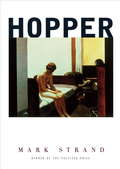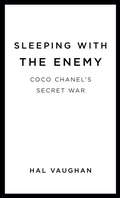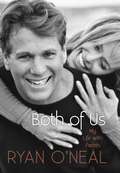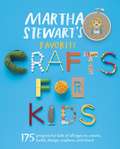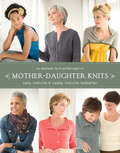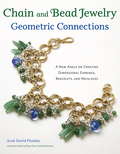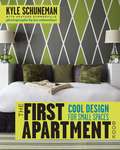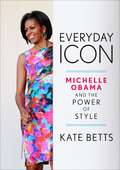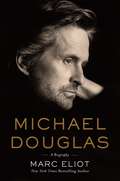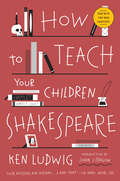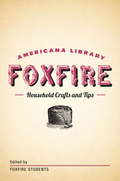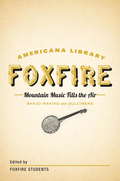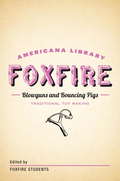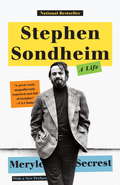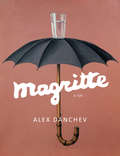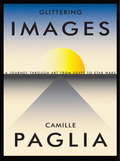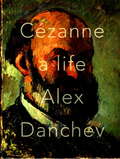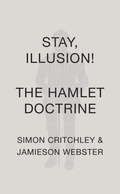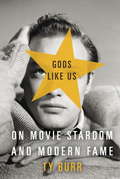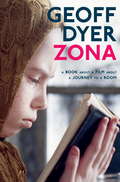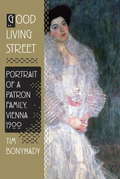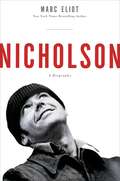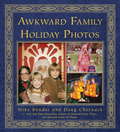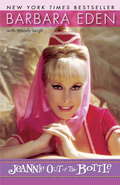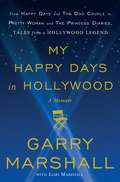- Table View
- List View
Hopper: Writers on Art
by Mark StrandNow in rich color, thirty of American painter Edward Hopper's masterpieces with critiques from acclaimed poet Mark Strand. Strand deftly illuminates the work of the frequently misunderstood American painter, whose enigmatic paintings--of gas stations, storefronts, cafeterias, and hotel rooms--number among the most powerful of our time. In brief but wonderfully compelling comments accompanying each painting, the elegant expressiveness of Strand's language is put to the service of Hopper's visual world. The result is a singularly illuminating presentation of the work of one of America's best-known artists. Strand shows us how the formal elements of the paintings--geometrical shapes pointing beyond the canvas, light from unseen sources--locate the viewer, as he says, "in a virtual space where the influence and availability of feeling predominate." An unforgettable combination of prose and painting in their highest forms, this book is a must for poetry and art lovers alike.
Sleeping with the Enemy: Coco Chanel's Secret War
by Hal Vaughan"From this century, in France, three names will remain: de Gaulle, Picasso, and Chanel." -André MalrauxCoco Chanel created the look of the modern woman and was the high priestess of couture.She believed in simplicity, and elegance, and freed women from the tyranny of fashion. She inspired women to take off their bone corsets and cut their hair. She used ordinary jersey as couture fabric, elevated the waistline, and created bell-bottom trousers, trench coats, and turtleneck sweaters. In the 1920s, when Chanel employed more than two thousand people in her workrooms, she had amassed a personal fortune of $15 million and went on to create an empire.Jean Cocteau once said of Chanel that she had the head of "a little black swan." And, added Colette, "the heart of a little black bull." At the start of World War II, Chanel closed down her couture house and went across the street to live at the Hôtel Ritz. Picasso, her friend, called her "one of the most sensible women in Europe." She remained at the Ritz for the duration of the war, and after, went on to Switzerland. For more than half a century, Chanel's life from 1941 to 1954 has been shrouded in vagueness and rumor, mystery and myth. Neither Chanel nor her many biographers have ever told the full story of these years. Now Hal Vaughan, in this explosive narrative--part suspense thriller, part wartime portrait--fully pieces together the hidden years of Gabrielle "Coco" Chanel's life, from the Nazi occupation of Paris to the aftermath of World War II. Vaughan reveals the truth of Chanel's long-whispered collaboration with Hitler's high-ranking officials in occupied Paris from 1940 to 1944. He writes in detail of her decades-long affair with Baron Hans Günther von Dincklage, "Spatz" ("sparrow" in English), described in most Chanel biographies as being an innocuous, English-speaking tennis player, playboy, and harmless dupe--a loyal German soldier and diplomat serving his mother country and not a member of the Nazi party. In Vaughan's absorbing, meticulously researched book, Dincklage is revealed to have been a Nazi master spy and German military intelligence agent who ran a spy ring in the Mediterranean and in Paris and reported directly to Nazi propaganda minister Joseph Goebbels, right hand to Hitler.The book pieces together how Coco Chanel became a German intelligence operative; how and why she was enlisted in a number of spy missions; how she escaped arrest in France after the war, despite her activities being known to the Gaullist intelligence network; how she fled to Switzerland for a nine-year exile with her lover Dincklage. And how, despite the French court's opening a case concerning Chanel's espionage activities during the war, she was able to return to Paris at age seventy and triumphantly resurrect and reinvent herself--and rebuild what has become the iconic House of Chanel.From the Hardcover edition.
Both of Us: My Life with Farrah
by Jodee Blanco Ryan O'Neal Kent CarrollRyan O'Neal and Farrah Fawcett. He was the handsome Academy Award-nominated star of Paper Moon and the classic romance Love Story. She was the beautiful, all-American Charlie's Angel, whose poster adorned the bedroom walls of teenage boys everywhere. One of the most storied love affairs in Hollywood history, their romance has captivated fans and media alike for more than three decades. In a tragic turn, the world lost Farrah after a tragic battle with cancer in 2009, but in his intimate memoir Both of Us, Ryan brings their relationship to vivid life. Fans of each other from afar, Ryan and Farrah met through her husband, Lee Majors, and fell passionately in love. Soon, however, reality threatened their happiness and they struggled with some serious matters, including the disintegration of Farrah's marriage; Ryan's troubled relationship with his daughter, Tatum, and son, Griffin; mismatched career trajectories; and raising their young son, Redmond--all leading Ryan and Farrah to an inevitable split in 1997. Ryan fought to create a life on his own but never stopped longing for Farrah. Eventually he realized that he had lost his true soul mate. Older and wiser, he and Farrah found their way back to each other and were excited to start a new life together. But their bliss was cut short when Farrah was diagnosed with cancer and passed away just three years later. Ryan's deep love for Farrah and his devotion to preserving her memory are evident in Both of Us. Drawing on decades' worth of personal records and keepsakes, he has included never-before-seen photographs, letters exchanged between him and Farrah, and his own diaries, making this a poignant and compelling memento for her fans. Written with candor and emotional honesty, it is a true Hollywood love story.
Martha Stewart's Favorite Crafts for Kids: 175 Projects for Kids of All Ages to Create, Build, Design, Explore, and Share
by Editors of Martha Stewart LivingMartha Stewart's Favorite Crafts for Kids focuses on craft projects that children, aged three to twelve, can make with their parents. These projects are fun, yet serve a practical purpose; children can wear, decorate, and play with what they make. Filled with ideas for a range of ages, skill levels, and interests, this book lets children's creativity run wild, while creating precious memories as parents and kids learn and create as a team.
Mother-Daughter Knits
by Sally Melville Caddy Melville LedbetterKnit to flatter and fit!It sounds simple. But if every knitter knew how to do it, the unflattering sweater and the top that doesn't fit would be things of the past. Unfortunately, that's not the world we live in, and knitwear designer Sally Melville knows why: too many knitters choose the wrong pattern for their shape and size!After decades of teaching, designing, and writing about knitting, Sally Melville knows how to customize knitting patterns to fit a wide variety of body types perfectly. With a little planning and subtle alterations, you can make a garment that is just right for you! In Mother-Daughter Knits, Sally shares this knowledge for the first time. Together with her daughter, fellow knitwear designer Caddy Melville Ledbetter, Sally demystifies the process of picking the right pattern and modifying it to your body's advantage. Whether you're a beginning or experienced knitter, young or mature, an hourglass or a triangle, Sally and Caddy have you covered! The authors have designed 30 customizable garments for women of all shapes, heights, and ages, including:* a slimming Jackie Kennedy--style Camelot coat,* a reversible tank top with a scoop neck, * a Jane Austen--inspired jacket with an empire waist,* a flirty top that enhances feminine curves.With fascinating insight, practical advice, and patterns for both classic and avant-garde tastes, Mother-Daughter Knits just might be the most useful guide a knitter could have-whether she's young or just young at heart.From the Hardcover edition.
Chain and Bead Jewelry Geometric Connections
by Scott David PlumleeIn Chain and Bead Jewelry Geometric Connections, wirework jewelry designer Scott David Plumlee shares his techniques for creating an amazing array of original designs using copper, silver, brass, and gold jump rings, all inspired by geometric shapes. By adapting and building on the traditional Byzantine chain configuration, Scott creates unique collections of earrings, bracelets and necklaces, from three-sided Tripoli to the four-sided Quatrefoil to the five-sided Pentagon, plus innovative Organic designs, including fish, five- and six- pointed snowflakes, and a butterfly. The thorough "Chain and Bead Basics" chapter, which guides readers through all the essential tools and techniques, makes it easy for beginners to re-create these stunning pieces.From the Trade Paperback edition.
The First Apartment Book: Cool Design for Small Spaces
by Kyle SchunemanBreak out of the white-walled world of first apartments and tap in to your blue-sky decorating dreams with star designer Kyle Schuneman's smart, bold ideas for any budget. First apartments are so exciting because you can finally do what you want with your own space, but they can be tricky to decorate. Kyle Schuneman knows that a paper-thin wallet and four plain walls don't have to stand between you and your perfect home. Kyle, 26, is a decorating prodigy who has designed first apartments for friends, clients, and himself, braving logic-defying floor plans, space-challenged rooms, and picky landlords. In The First Apartment Book, Kyle shares brilliant design ideas and thirty simple DIY projects that show how anyone can infuse a first home with personality whether you're renting, moving in with a roommate or significant other for the first time, or are a newly minted owner eager to put your stamp on your place. The First Apartment Book is both a tour of amazing photographs from ten real homes across the country and a hardworking resource of great ideas. Kyle explains how each of the featured apartments achieves the perfect balance between cool design and the homeowner's lifestyle, with a sprinkling of influences from the resident's city thrown in. Kyle scours flea markets for functional pieces with personality and incorporates Pollock-inspired art and touches of taxicab yellow to make a small studio in New York City function as four different yet coherent rooms. o Graffiti-like dip-dye curtains and a skateboard table reflect a Seattle renter's hip sensibility. In Cleveland, Kyle creates a modern preppy space for a plaid-loving local using subdued colors and careful pattern mixing. A couple's salon-style hanging of rock posters in Nashville feels utterly unique, and Kyle's clever ideas for storing to store their musical instruments keep the duo sane. Short on time and long on style, the thirty DIY projects include no-sew pillows, yarn-wrapped picture frames, and a dresser update using a little glue and fabric. Full of bold, vibrant photos and hundreds of big ideas for small spaces, The First Apartment Book proves that no matter what your landlord, your floor plan, or your wallet says, there are no limits on how cool your first apartment can be.
Everyday Icon: Michelle Obama and the Power of Style
by Kate BettsIn many ways the world has never seen a First Lady like Michelle Obama. From the precedent of her race to the singularity of her style, she has been the object of immense fascination. What she says, what she does, and not least, what she wears, is scrutinized around the world.Writing at the crossroads of politics and fashion, Kate Betts explains why Michelle Obama's style matters, and how she has helped liberate a generation of women from the false idea that style and substance are mutually exclusive. Following the transformation of Mrs. Obama from her early days on the campaign trail to her first state dinner at the White House, Betts, a longtime fashion journalist and former editor in chief of Harper's Bazaar, reminds us that while style can be expressed in what you wear, it is inextricably bound up in who you are and what you believe in. In a smart, breezy voice backed by extensive interviews and historical research, Betts shows how Michelle Obama's bold confidence and self-possession have made her into an icon and transformed the way women see themselves, their roles, and their own style.With two hundred color photographs, original designer sketches, and historical images, Everyday Icon is not only a lavish tour of our First Lady's style statements, but also a fascinating behind-the-scenes account of how she created her image and, more important, what that image says about American style today. Much has been written about Michelle Obama, but Kate Betts places her in a broader cultural and historical context; Everyday Icon is the definitive book on how a working mother of two became an unforgettable, global style icon.From the Hardcover edition.
Michael Douglas: A Biography
by Marc EliotThrough determination, inventiveness, and charisma, Michael Douglas emerged from the long shadow cast by his movie-legend father, Kirk Douglas, to become his own man and one of the film industry's most formi dable players. Overcoming the curse of failure that haunts the sons and daughters of Hollywood celebrities, Michael became a sensation when he successfully brought One Flew Over the Cuckoo's Nest, starring his friend Jack Nicholson, to the screen after numerous setbacks, including his father's own failed attempts to make it happen. This 1975 box-office phenomenon won Michael his first Oscar (the film won five total, including Best Picture), an award Kirk hadn't won at the time, and solidified the turbulent, competitive father-son relationship that would shape Michael's career and personal life. In the decades that followed, Michael established a reputation for taking chances on new talent and proj ects by producing and starring in the hugely successful Romancing the Stone and Jewel of the Nile movies, while cultivating a multifaceted acting persona edgy, rebel lious, and a little dark in such films as Wall Street, Fatal Attraction, Basic Instinct, and Disclosure. Yet as his career thrived, Michael's personal life floundered, with an unhappy and tumultuous first mar riage, rumors of infidelity (especially with leading ladies such as Kathleen Turner), and a headline-grabbing stint in rehab. Rocked by a series of tragedies, including Kirk's strokes, his son Cameron's incarceration, and his own fight against throat cancer, Michael has emerged trium phant, healthy, and happy in his marriage to Catherine Zeta-Jones, a Welsh actress twenty-five years his junior, and their new young family. In Michael Douglas, Marc Eliot brings into sharp fo cus this incredible career, complicated personal life, and legendary Hollywood family. Eliot's fascinating portrait of the lows and remarkable highs in Michael's life in cluding the thorny yet influential relationship with his father breaks boundaries in understanding the life and work of a true American film star.
How to Teach Your Children Shakespeare
by Ken LudwigA foolproof, enormously fun method of teaching your children the classic works of William Shakespeare, by a Tony Award–winning playwright—now featuring two new chapters &“You and your children will be transformed by the magic and mystery of Shakespeare and his stories in an instant.&”—Sir Derek Jacobi, CBE Winner of the Falstaff Award for Best Shakespeare BookTo know some Shakespeare provides a head start in life. His plays are among the great bedrocks of Western civilization and contain the finest writing of the past 450 years. Many of the best novels, plays, poems, and films in the English language produced since Shakespeare&’s death in 1616—from Pride and Prejudice to The Godfather—are heavily influenced by Shakespeare&’s stories, characters, language, and themes. In How to Teach Your Children Shakespeare, acclaimed playwright Ken Ludwig provides the tools you need to inspire an understanding, and a love, of Shakespeare&’s works in your children, and to have fun together along the way.Ken Ludwig devised his friendly, easy-to-master methods while teaching his own children. Beginning with memorizing short passages from the plays, his technique then instills children with cultural references they will utilize for years to come. Ludwig&’s approach includes understanding of the time period and implications of Shakespeare&’s diction as well as the invaluable lessons behind his words and stories. Colorfully incorporating the history of Shakespearean theater and society, How to Teach Your Children Shakespeare guides readers on an informed and adventurous journey through the world in which the Bard wrote.This book&’s simple process allows anyone to impart to children the wisdom of plays like A Midsummer Night&’s Dream, Twelfth Night, Macbeth, and Romeo and Juliet. And there&’s fun to be had throughout. Shakespeare novices and experts and readers of all ages will each find something delightfully irresistible in How to Teach Your Children Shakespeare.
Household Crafts and Tips: The Foxfire Americana Library (12) (The Foxfire Americana Library)
by Inc. Foxfire FundA collection of how-tos celebrating the domestic arts of Appalachia, "Household Crafts and Tips" includes traditional advice on soapmaking and quilting, as well as in-depth instructions for making baskets, hampers, cornhusk brooms, and hanging gourds for purple martins.
Mountain Music Fills the Air: The Foxfire Americana Libray (11) (The Foxfire Americana Library)
by Inc. Foxfire FundBanjos and dulcimers have always been an essential part of Appalachian music, shared and enjoyed throughout the generations. Here, musicians share the history of the instruments and show how they are constructed, piece by piece, with photos and diagrams.
Blowguns and Bouncing Pigs: The Foxfire Americana Library (6) (The Foxfire Americana Library)
by Inc. Foxfire FundThe Foxfire Americana Library takes you back to the good ol' days with a collection of simple, classic toys that can be made at home. Complete with illustrated step-by-step instructions, "Blowguns and Bouncing Pigs" includes advice on how to make: Ball and CupsBlowgunsBouncing PigsBows and ArrowsBubble BlowersBull GrindersButtons on a StringClimbing BearsCorn GunsCornstalk AnimalsCornstalk FiddleApple-head DollsCucumber DollsFluttermillsFly GunsHoopsJumping JacksKicking MulesLimberjacksPop GunsPuzzlesRattletrapsRolling ClownsSling ShotsSmoke GrindersSquirt GunsStick HorsesStiltsGrapevine SwingsRope SwingsTops or DancersWhimmy Diddles or Jeep SticksHollow WhistlesSplit WhistlesWhittled Animals
Stephen Sondheim: A Life
by Meryle SecrestIn the first full-scale life of the most important composer-lyricist at work in musical theatre today, Meryle Secrest, the biographer of Frank Lloyd Wright and Leonard Bernstein, draws on her extended conversations with Stephen Sondheim as well as on her interviews with his friends, family, collaborators, and lovers to bring us not only the artist--as a master of modernist compositional style--but also the private man. Beginning with his early childhood on New York's prosperous Upper West Side, Secrest describes how Sondheim was taught to play the piano by his father, a successful dress manufacturer and amateur musician. She writes about Sondheim's early ambition to become a concert pianist, about the effect on him of his parents' divorce when he was ten, about his years in military and private schools. She writes about his feelings of loneliness and abandonment, about the refuge he found in the home of Oscar and Dorothy Hammerstein, and his determination to become just like Oscar.Secrest describes the years when Sondheim was struggling to gain a foothold in the theatre, his attempts at scriptwriting (in his early twenties in Rome on the set of Beat the Devil with Bogart and Huston, and later in Hollywood as a co-writer with George Oppenheimer for the TV series Topper), living the Hollywood life.Here is Sondheim's ascent to the peaks of the Broadway musical, from his chance meeting with play-wright Arthur Laurents, which led to his first success--as co-lyricist with Leonard Bernstein on West Side Story--to his collaboration with Laurents on Gypsy, to his first full Broadway score, A Funny Thing Happened on the Way to the Forum. And Secrest writes about his first big success as composer, lyricist, writer in the 1960s with Company, an innovative and sophisticated musical that examined marriage à la mode. It was the start of an almost-twenty-year collaboration with producer and director Hal Prince that resulted in such shows as Follies, Pacific Overtures, Sweeney Todd, and A Little Night Music.We see Sondheim at work with composers, producers, directors, co-writers, actors, the greats of his time and ours, among them Leonard Bernstein, Ethel Merman, Richard Rodgers, Oscar Hammerstein, Jerome Robbins, Zero Mostel, Bernadette Peters, and Lee Remick (with whom it was said he was in love, and she with him), as Secrest vividly re-creates the energy, the passion, the despair, the excitement, the genius, that went into the making of show after Sondheim show.A biography that is sure to become the standard work on Sondheim's life and art.
Magritte: A Life
by Alex DanchevThe first major biography of the pathbreaking, perpetually influential surrealist artist and iconoclast whose inspiration can be seen in everyone from Jasper Johns to Beyoncé—by the celebrated biographer of Cézanne and BraqueIn this thought-provoking life of René Magritte (1898‒1967), Alex Danchev makes a compelling case for Magritte as the single most significant purveyor of images to the modern world. Magritte&’s surreal sensibility, deadpan melodrama, and fine-tuned outrageousness have become an inescapable part of our visual landscape, through such legendary works as The Treachery of Images (Ceci n&’est pas une pipe), and his celebrated iterations of Man in a Bowler Hat. Danchev explores the path of this highly unconventional artist, from his middle-class Belgian beginnings to the years in which he led a small, brilliant band of surrealists (and famously clashed with André Breton) to his first major retrospective, which traveled to the United States in 1965 and gave rise to his international reputation. Using thirty-two pages of color images and more than 160 black-and-white illustrations throughout the text, Danchev delves deeply into Magritte&’s artistic development and the profound questions he raised in his work about the very nature of authenticity.
Glittering Images
by Camille PagliaFrom the best-selling author of Sexual Personae and Break, Blow, Burn and one of our most acclaimed cultural critics, here is an enthralling journey through Western art's defining moments, from the ancient Egyptian tomb of Queen Nefertari to George Lucas's volcano planet duel in Revenge of the Sith.America's premier intellectual provocateur returns to the subject that brought her fame, the great themes of Western art. Passionately argued, brilliantly written, and filled with Paglia's trademark audacity, Glittering Images takes us on a tour through more than two dozen seminal images, some famous and some obscure or unknown--paintings, sculptures, architectural styles, performance pieces, and digital art that have defined and transformed our visual world. She combines close analysis with background information that situates each artist and image within its historical context--from the stone idols of the Cyclades to an elegant French rococo interior to Jackson Pollock's abstract Green Silver to Renée Cox's daring performance piece Chillin' with Liberty. And in a stunning conclusion, she declares that the avant-garde tradition is dead and that digital pioneer George Lucas is the world's greatest living artist. Written with energy, erudition, and wit, Glittering Images is destined to change the way we think about our high-tech visual environment.
Cezanne
by Alex DanchevAlex Danchev gives us the first comprehensive assessment of the revolutionary work and restless life of Paul Cézanne to be published in decades. One of the most influential painters of his time and beyond, Cézanne was the exemplary artist-creator of the modern age who changed the way we see the world. With brisk intellect, rich documentation, and eighty-eight color and fifty-two black-and-white illustrations, Danchev tells the story of an artist who was originally considered a madman, a barbarian, and a sociopath. Beginning with the unsettled teenager in Aix, Danchev takes us through the trials of a painter who believed that art must be an expression of temperament but was tormented by self-doubt, who was rejected by the Salon for forty years, who sold nothing outside his immediate circle until his thirties, who had a family that he kept secret from his father until his forties, who had his first exhibition at the age of fifty-six--but who fiercely maintained his revolutionary beliefs. Danchev shows us how the beliefs Cézanne held and the life he led became the obsession and inspiration of artists, writers, poets, and philosophers from Henri Matisse and Pablo Picasso to Samuel Beckett and Allen Ginsberg. A special feature of the book is a remarkable series of Cézanne's self-portraits, reproduced in full color. Cézanne is not only the fascinating life of a visionary artist and extraordinary human being but also a searching assessment of his ongoing influence in the artistic imagination of our time. A stunning portrait of a monumentally important artist, this is a biography not to be missed.
Stay, Illusion!
by Simon Critchley Jamieson WebsterThe figure of Hamlet haunts our culture like the ghost haunts Shakespeare's melancholy Dane. Arguably, no literary work is more familiar to us. Everyone knows at least six words from Hamlet, and most people know many more. Yet the play--Shakespeare's longest--is more than "passing strange," and it becomes even more complex when considered closely. Reading Hamlet alongside other writers, philosophers, and psychoanalysts--Carl Schmitt, Walter Benjamin, Freud, Lacan, Nietzsche, Melville, and Joyce--Simon Critchley and Jamieson Webster go in search of a particularly modern drama that is as much about ourselves as it is a product of Shakespeare's imagination. They also offer a startling interpretation of the action onstage: it is structured around "nothing"--or, in the enigmatic words of the player queen, "it nothing must." From the illusion of theater and the spectacle of statecraft to the psychological interplay of inhibition and emotion, Hamlet discloses the modern paradox of our lives: how thought and action seem to pull against each other, the one annulling the possibility of the other. As a counterweight to Hamlet's melancholy paralysis, Ophelia emerges as the play's true hero. In her madness, she lives the love of which Hamlet is incapable. Avoiding the customary clichés about the timelessness of the Bard, Critchley and Webster show the timely power of Hamlet to cast light on the intractable dilemmas of human existence in a world that is rotten and out of joint.
Gods Like Us
by Ty BurrWITH 8 PAGES OF BLACK-AND-WHITE PHOTOGRAPHSHow--and why--do we obsess over movie stars? How does fame both reflect and mask the person behind it? How have the image of stardom and our stars' images altered over a century of cultural and technological change? Do we create celebrities, or do they create us? Ty Burr, film critic for The Boston Globe, answers these questions in this lively and fascinating anecdotal history of stardom, with all its blessings and curses for star and stargazer alike. From Mary Pickford and Charlie Chaplin to Archie Leach (a.k.a. Cary Grant) and Marion Morrison (a.k.a. John Wayne), Tom Cruise and Julia Roberts, and such no-cal stars of today as the Kardashians and the new online celebrity (i.e., you and me), Burr takes us on an insightful and entertaining journey through the modern fame game at its flashiest, most indulgent, occasionally most tragic, and ultimately, its most revealing.ine celebrity (i.e., you and me), Burr takes us on a brilliantly insightful and entertaining journey through the modern fame game at its flashiest, its most indulgent, occasionally its most tragic and, ultimately, its most culturally revealing.From the Hardcover edition.
Zona: A Book About a Film About a Journey to a Room
by Geoff DyerFrom a writer whose mastery encompasses fiction, criticism, and the fertile realm between the two, comes a new book that confirms his reputation for the unexpected.In Zona, Geoff Dyer attempts to unlock the mysteries of a film that has haunted him ever since he first saw it thirty years ago: Andrei Tarkovsky's Stalker, widely regarded as one of the greatest films of all time. ("Every single frame," declared Cate Blanchett, "is burned into my retina.") As Dyer guides us into the zone of Tarkovsky's imagination, we realize that the film is only the entry point for a radically original investigation of the enduring questions of life, faith, and how to live. In a narrative that gives free rein to the brilliance of Dyer's distinctive voice--acute observation, melancholy, comedy, lyricism, and occasional ill-temper--Zona takes us on a wonderfully unpredictable journey in which we try to fathom, and realize, our deepest wishes.Zona is one of the most unusual books ever written about film, and about how art--whether a film by a Russian director or a book by one of our most gifted contemporary writers--can shape the way we see the world and how we make our way through it.
Good Living Street
by Tim BonyhadyVienna and its Secessionist movement at the turn of the last century is the focus of this extraordinary social portrait told through an eminent Viennese family, headed by Hermine and Moriz Gallia, who were among the great patrons of early-twentieth-century Viennese culture at its peak. Good Living Street takes us from the Gallias' middle-class prosperity in the provinces of central Europe to their arrival in Vienna, following the provision of Emperor Franz Joseph in 1848 that gave Jews freedom of movement and residence, legalized their religious services, opened public service and professions up to them, and allowed them to marry. The Gallias, like so many hundreds of thousands of others, came from across the Hapsburg Empire to Vienna, and for the next two decades the city that became theirs was Europe's center of art, music, and ideas. The Gallias lived beyond the Ringstrasse in Vienna's Fourth District on the Wohllebengasse (translation: Good Living Street), named after Vienna's first nineteenth-century mayor. In this extraordinary book we see the amassing of the Gallias' rarefied collections of art and design; their cosmopolitan society; we see their religious life and their efforts to circumvent the city's rampant anti-Semitism by the family's conversion to Catholicism along with other prominent intellectual Jews, among them Gustav Mahler. While conversion did not free Jews from anti-Semitism, it allowed them to secure positions otherwise barred to them. Two decades later, as Kristallnacht raged and Vienna burned, the Gallias were having movers pack up the contents of their extraordinary apartment designed by Josef Hoffmann. The family successfully fled to Australia, bringing with them the best private collection of art and design to escape Nazi Austria; included were paintings, furniture, three sets of silver cutlery, chandeliers, letters, diaries, books and bookcases, furs--chinchilla, sable, sealskin--and even two pianos, one upright and one Steinway. Not since the publication of Carl Schorske's acclaimed portrait of Viennese modernism, Fin-de-Siècle Vienna, has a book so brilliantly--and completely--given us this kind of close-up look at turn-of-the-last-century Viennese culture, art, and daily life--when the Hapsburg Empire was fading and modernism and a new order were coming to the fore. Good Living Street re-creates its world, atmosphere, people, energy, and spirit, and brings it all to vivid life.From the Hardcover edition.
Nicholson: A Biography
by Marc EliotTHE GROUNDBREAKING NEW BIOGRAPHY OF A MAN WITH ONE OF THE MOST ICONIC AND FASCINATING CAREERS--AND LIVES--IN HOLLYWOOD. For five decades, Jack Nicholson has been part of film history. With twelve Oscar nominations to his credit and legendary roles in films like Easy Rider, Five Easy Pieces, Terms of Endearment, The Shining, and One Flew Over the Cuckoo's Nest, Nicholson creates original, memorable characters like no other actor of his generation. And his personal life has been no less of an adventure--Nicholson has always been at the center of the Hollywood elite and has courted some of the most famous and beautiful women in the world. Relying on years of extensive research and interviews with insiders who know Nicholson best, acclaimed biographer Marc Eliot sheds new light on Nicholson's life on and off the screen. From Nicholson's working class childhood in New Jersey, where family secrets threatened to tear his family apart, to raucous nights on the town with Warren Beatty and tumultuous relationships with starlets like Michelle Phillips, Anjelica Huston, and Lara Flynn Boyle, to movie sets working with such legendary directors and costars as Dennis Hopper, Stanley Kubrick, Meryl Streep, and Roman Polanski, Eliot paints a sweeping picture of the breadth of Nicholson's fifty-year career in film, as well as an intimate portrait of his personal life. Equally at home on the bookshelves of serious film historians and fans of compulsively readable Hollywood biographies, Nicholson is both a comprehensive tribute to a film legend and an entertaining look at a truly remarkable life.
Awkward Family Holiday Photos
by Doug Chernack Mike BenderFrom the authors of the New York Times bestsellers Awkward Family Photos and Awkward Family Pet Photos comes a celebration of those special times throughout the year when our families embarrass us the most . . . the holidays.Holidays. They're those momentous occasions when we gather with family to eat, drink, celebrate, and, of course, pose for photographs. From Mom's homemade Halloween costumes to re-creating a Nativity scene for the Christmas card to that overly patriotic uncle who literally wears the flag on the Fourth, holidays make for humiliating memories that we carry in our hearts for years to come. Whether your family loves Valentine's Day, St. Patrick's Day, Easter, July Fourth, Halloween, Thanksgiving, Christmas, or Hanukkah, this book pays homage to all of the holidays' most uncomfortable moments.
Jeannie Out of the Bottle
by Wendy Leigh Barbara EdenA magical, heartwarming memoir from one of Hollywood's most beloved icons Over the past four decades, the landmark NBC hit television series I Dream of Jeannie has delighted generations of audiences and inspired untold numbers of teenage crushes on its beautiful blond star, Barbara Eden. Part pristine Hollywood princess and part classic bombshell, with innocence, strength, and comedic talent to spare, Barbara finally lets Jeannie out of her bottle to tell her whole story. Jeannie Out of the Bottle takes us behind the scenes of I Dream of Jeannie as well as Barbara's dozens of other stage, movie, television, and live concert performances. We follow her from the hungry years when she was a struggling studio contract player at 20th Century Fox through difficult weeks trying to survive as a chorus girl at Ciro's Sunset Strip supper club, from a stint as Johnny Carson's sidekick on live TV to tangling on-screen and off with some of Hollywood's most desirable leading men, including Elvis Presley, Clint Eastwood, Paul Newman, and Warren Beatty. From the ups and downs of her relationship with her Jeannie co-star Larry Hagman to a touching meeting with an exquisite and vulnerable Marilyn Monroe at the twilight of her career, readers join Barbara on a thrilling journey through her five decades in Hollywood. But Barbara's story is also an intimate and honest memoir of personal tragedy: a stillborn child with her first husband, Michael Ansara; a verbally abusive, drug-addicted second husband; the loss of her beloved mother; and the accidental heroin-induced death of her adult son, just months before his wedding. With candor and poignancy, Barbara reflects on the challenges she has faced, as well as the joys she has experienced and how she has maintained her humor, optimism, and inimitable Jeannie magic throughout the roller-coaster ride of a truly memorable life. Illustrated with sixteen pages of photographs, including candid family pictures and rare publicity stills, Jeannie Out of the Bottle is a must-have for every fan, old and new.From the Hardcover edition.
My Happy Days in Hollywood: A Memoir
by Garry MarshallWith the television hits The Odd Couple, Happy Days, Laverne & Shirley, and Mork & Mindy, and movies like The Flamingo Kid, Beaches, Pretty Woman, and The Princess Diaries under his belt, Garry Marshall has been among the most successful writers, directors, and producers in America for more than five decades. His work on the small and big screen has delighted audiences for the last three decades and has withstood the test of time. In My Happy Days in Hollywood, Marshall takes us on a journey from his stickball-playing days in the Bronx to his time at the helm of some of the most popular television series and movies of all time, sharing the joys and challenges of working with the Fonz and the young Julia Roberts, the "street performer" Robin Williams, and the young Anne Hathaway, among many others. This honest, vibrant, and often hilarious memoir reveals a man whose career has been defined by his drive to make people laugh and whose personal philosophy--despite his tremendous achievements--has always been that life is more important than show business.From the Hardcover edition.
